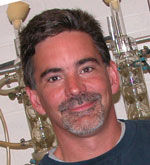 Michael Milligan, Ph.D. |
A $6.5 million grant from the Environmental Protection Agency has been awarded to researchers at SUNY Fredonia and two other New York universities to fund the Great Lakes Fish Monitoring and Surveillance Program.
Part of the Great Lakes Restoration Initiative, the five-year grant continues the partnership of Clarkson University, SUNY Oswego and SUNY Fredonia and follows a $1.75 million award the partnership received in 2006 to provide chemical analysis of Great Lakes fish tissue.
SUNY Fredonia Chemistry professor Michael Milligan is serving as a principal investigator in the study, as are Thomas Holsen, Civil & Environmental Engineering, and Bernard Crimmins, Center for Air Resources Engineering and Science, both of Clarkson, and James Pagano, director, Environmental Research Center, SUNY Oswego.
The grant will continue analysis for contaminants to assess temporal trends in organic compounds and mercury in open waters of the Great Lakes, using fish as biomonitors. Additional analytical instruments that the grant supports will transform the Great Lakes monitoring program into a world leader in the science of contaminant cycling in aquatic eco-systems. Identification of both current and emerging contaminants, such as flame retardants, present in the Great Lakes eco-system will be enhanced by the use of these instruments.
The three-university team will monitor temporal trends in bioaccumulative chemicals in the Great Lakes by using top predator fish as biomonitors, screen for new compounds of concern entering the lake eco-systems and assess the ecological health of the Great Lakes through interpretation of chemical analyses and other food web studies. The study will improve the understanding of pollutant impacts on the fisher and efforts to remediate and reduce pollutant sources.



